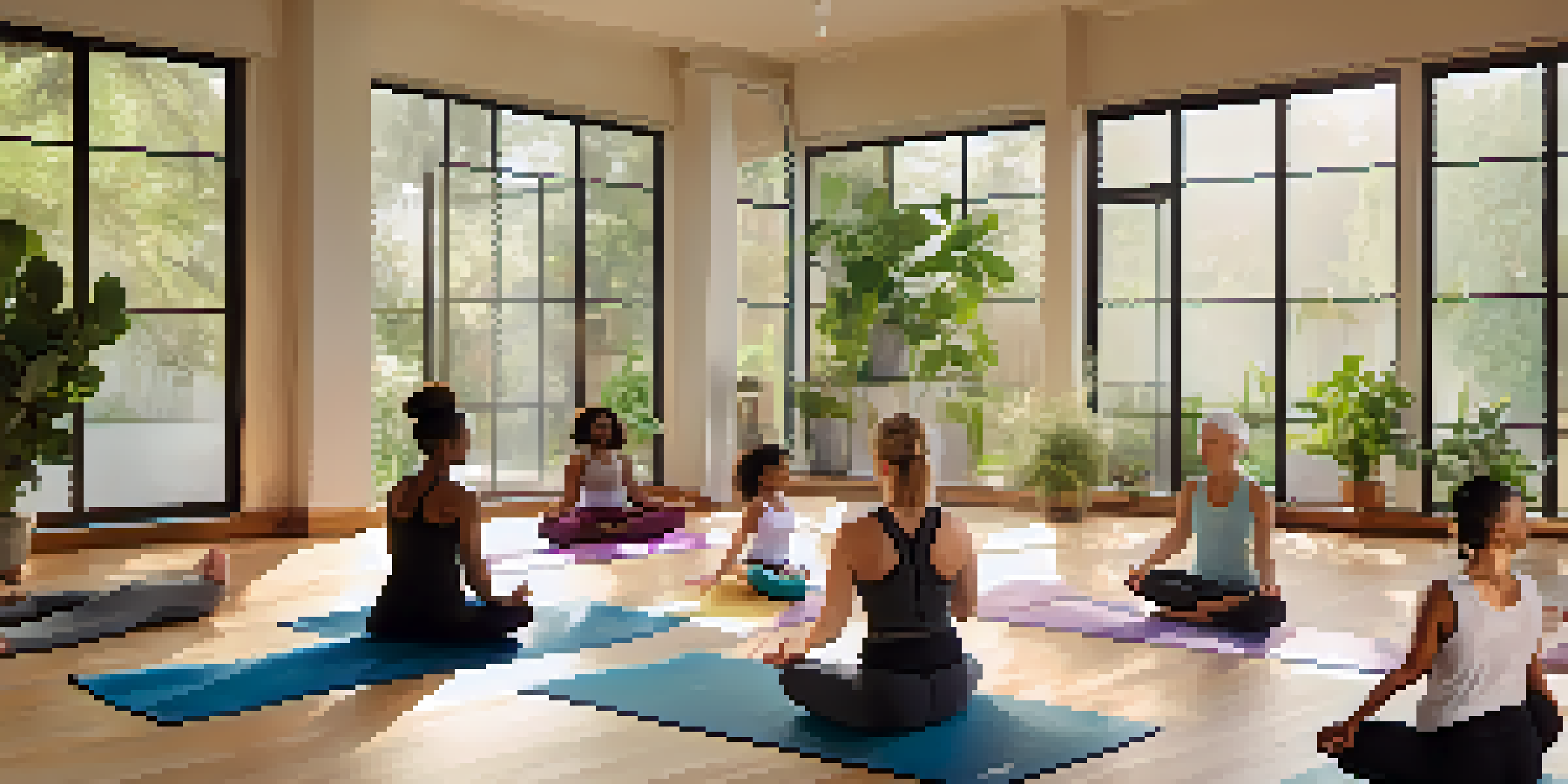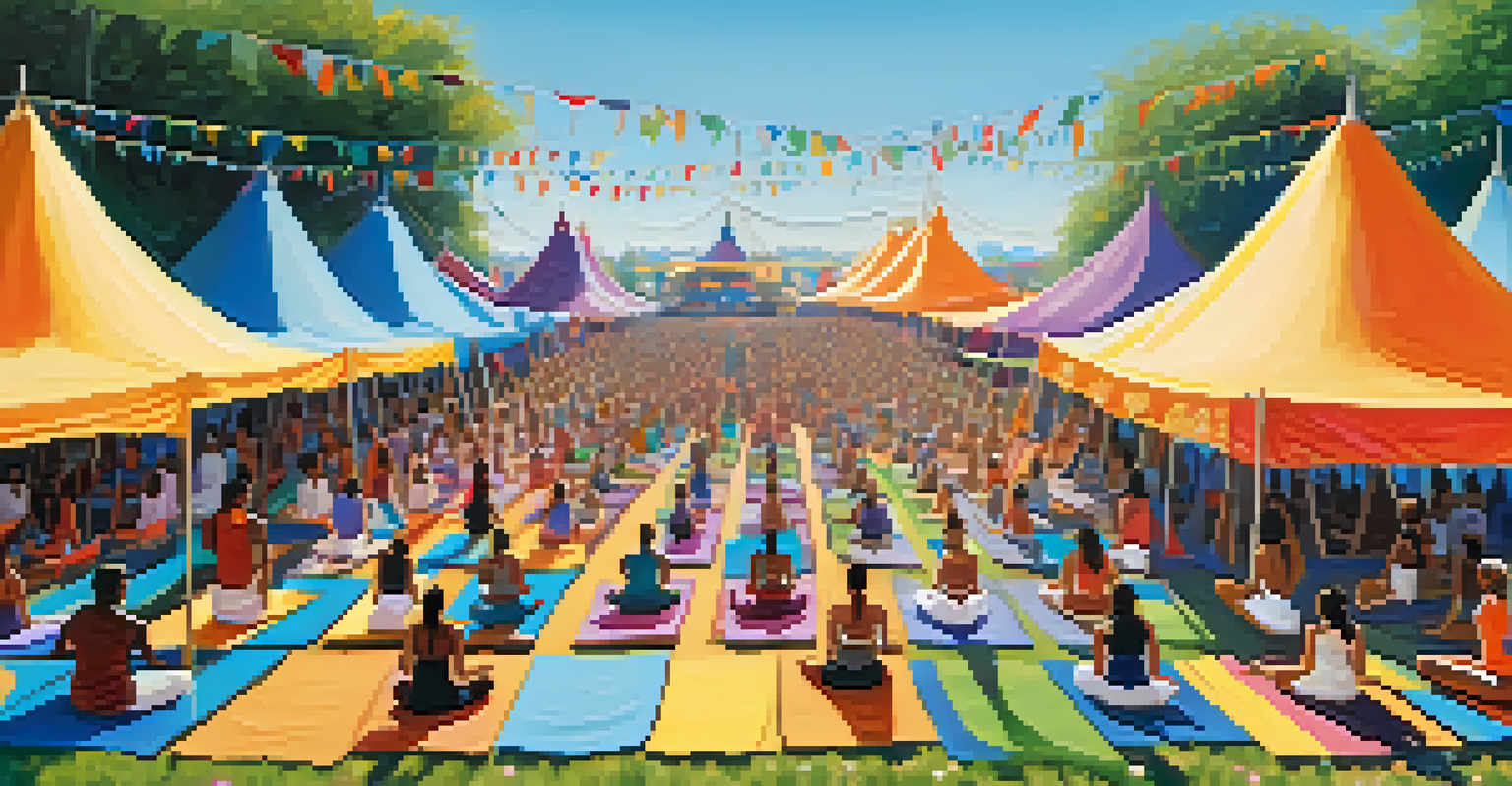Yoga: A Pathway to Cultural Understanding and Integration

Yoga's Roots: A Journey Through Diverse Cultures
Yoga, originating in ancient India, is more than just a physical practice; it's a rich tapestry woven from various cultures and philosophies. This intricate history offers a glimpse into the spiritual and communal aspects of yoga, inviting practitioners to explore different cultural narratives. Each style of yoga, from Hatha to Vinyasa, reflects unique traditions and beliefs, making it a fascinating study of cultural diversity.
Yoga is not about touching your toes, it’s about what you learn on the way down.
As yoga spread across the globe, it absorbed influences from the cultures it encountered, creating a dynamic exchange. For instance, the incorporation of mindfulness practices from Buddhism into yoga shows how cultures can influence one another positively. This melting pot of ideas encourages practitioners to appreciate the broader cultural contexts from which these practices arise.
By understanding yoga's diverse roots, practitioners can cultivate a deeper respect for the traditions that shape their practice. This awareness not only enhances personal growth but also fosters a sense of unity among individuals from different backgrounds, enriching the overall experience of yoga.
Connecting Through Shared Practices and Rituals
One of the beautiful aspects of yoga is its ability to bring people together through shared practices and rituals. Classes often become melting pots where individuals from various backgrounds come together to learn and grow. This shared journey fosters connections that transcend cultural barriers, creating a sense of community among practitioners.

Rituals, such as the opening 'om' chant or closing meditation, serve as communal touchpoints that remind participants of their shared goals and experiences. These moments of collective energy can transform a simple yoga class into a profound experience of unity and understanding. It's a reminder that, regardless of our differences, we all seek connection and peace.
Yoga's Cultural Roots Matter
Understanding yoga's diverse origins enhances personal growth and fosters respect for different traditions.
By participating in these shared practices, individuals can develop empathy and appreciation for one another's cultural backgrounds. This not only enhances the yoga experience but also encourages a broader dialogue about cultural understanding and integration, promoting harmony in diverse communities.
Language of Yoga: Bridging Communication Gaps
Yoga serves as a universal language that transcends spoken words, allowing individuals from all walks of life to connect. Poses like Downward Dog or Warrior II are recognized globally, fostering a sense of familiarity and camaraderie among practitioners. This shared vocabulary can break down communication barriers and create an environment where everyone feels included.
The body is your temple. Keep it pure and clean for the soul to reside in.
Moreover, many yoga instructors integrate cultural stories and philosophies into their classes, providing context to the poses and practices. This narrative approach not only enriches the experience but also encourages participants to engage in conversations about the origins and meanings behind what they practice. Such discussions can lead to greater cultural appreciation and understanding.
Through the language of yoga, individuals can find common ground, even when their spoken languages differ. This aspect of yoga highlights the importance of non-verbal communication in building connections and encourages a more inclusive atmosphere within yoga communities.
Mindfulness and Cultural Sensitivity in Practice
Mindfulness, a key component of yoga, promotes a heightened awareness of both self and others. This practice encourages individuals to reflect on their cultural biases and assumptions, fostering a more inclusive mindset. As practitioners become more aware of their own thoughts and behaviors, they can approach interactions with greater empathy and openness.
Incorporating mindfulness into yoga practices allows individuals to appreciate the diverse backgrounds of fellow practitioners. By being present and attentive, they can learn from one another's experiences, creating an environment of mutual respect. This cultural sensitivity enhances the sense of community and enriches the practice for everyone involved.
Community Through Shared Practices
Shared rituals in yoga classes create connections that transcend cultural barriers, promoting empathy and unity.
Ultimately, mindfulness serves as a bridge to deeper cultural understanding, urging practitioners to listen actively and engage thoughtfully. This not only benefits individual growth but also cultivates an atmosphere where cultural diversity is celebrated and embraced.
Yoga Festivals: Celebrating Global Cultures Together
Yoga festivals around the world serve as vibrant celebrations of cultural diversity and community. These events often feature a mix of yoga styles, workshops, and cultural performances, creating an immersive experience for attendees. By participating in such festivals, individuals can explore various traditions and practices, broadening their understanding of yoga's cultural significance.
These gatherings also provide a platform for dialogue and exchange among practitioners from different backgrounds. Attendees can share their stories, experiences, and insights, fostering a sense of global connectedness. This exchange of ideas not only enriches personal practice but also strengthens the bonds between diverse communities.
By celebrating yoga in a festival setting, individuals are reminded of the joy that comes from cultural integration. It's an opportunity to learn, grow, and appreciate the beauty of diversity, reinforcing the idea that yoga is a pathway to unity.
Yoga as a Tool for Social Change and Advocacy
Yoga goes beyond the mat; it can also be a powerful tool for social change and advocacy. Many yoga practitioners and teachers are using their platforms to raise awareness about cultural issues and promote inclusivity. By addressing topics like social justice within yoga spaces, they are fostering a culture of activism and awareness among practitioners.
This advocacy can take many forms, from community outreach programs to workshops focused on cultural sensitivity. By incorporating these elements into yoga practice, communities can engage in meaningful discussions about diversity and inclusion. This proactive approach encourages individuals to take action and contribute to positive change both within and outside the yoga community.
Yoga as a Catalyst for Change
Yoga practitioners are using their platforms to advocate for social change, emphasizing inclusivity and cultural sensitivity.
Ultimately, by using yoga as a platform for social change, practitioners can amplify voices that may otherwise go unheard. This not only promotes cultural understanding but also reinforces the idea that yoga can be a catalyst for a more equitable society.
The Future of Yoga: Embracing Cultural Integration
As yoga continues to evolve, the focus on cultural integration and understanding becomes increasingly important. Future practitioners have the opportunity to learn from the past while shaping a practice that honors its diverse roots. This involves not only embracing different styles but also fostering an environment where everyone feels valued and heard.
To achieve this, yoga communities must prioritize inclusivity and accessibility, ensuring that individuals from all backgrounds can participate. This may involve offering classes in various languages, adapting practices to consider cultural nuances, or addressing potential barriers to entry. By creating a welcoming environment, yoga can thrive as a truly global practice.

In this way, the future of yoga is bright and full of potential for cultural integration. By embracing diversity and fostering understanding, we can build a stronger, more connected community that celebrates the rich tapestry of human experience.